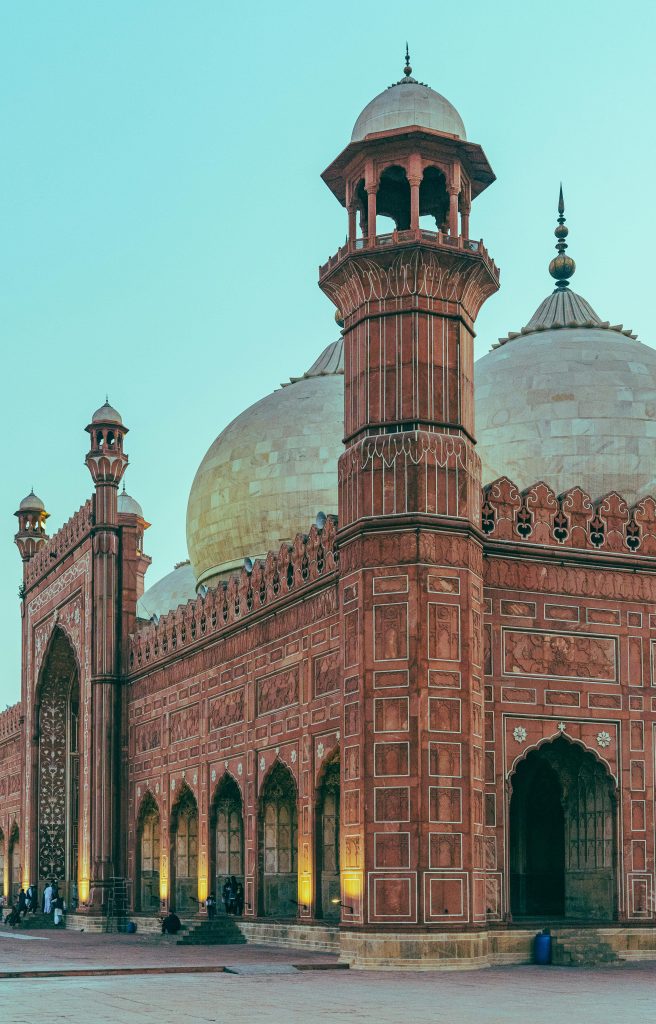Introduction
The Badshahi Mosque, located in Lahore, Punjab, Pakistan, is one of the most iconic landmarks of the Mughal era. Constructed between 1671 and 1673 during the rule of Emperor Aurangzeb, it stands as a testament to the architectural prowess and cultural heritage of the Mughal dynasty.
Historical Background
Construction and Design
The mosque was built under the supervision of Aurangzeb’s foster brother, Muzaffar Hussein, also known as Fidai Khan Koka, who was the Governor of Lahore at the time. The construction took only two years, and the mosque was completed and opened in 1673. The exterior of the mosque is adorned with carved red sandstone with intricate marble inlay, showcasing the grandeur of Mughal architecture.
Purpose and Significance
Aurangzeb chose Lahore as the site for his mosque to commemorate his military campaigns in southern India, particularly against the Maratha Emperor Shivaji. The mosque was strategically positioned opposite the Lahore Fort and its Alamgiri Gate, which was also built by Aurangzeb. This positioning emphasized the mosque’s significance and its connection to the emperor’s military achievements.
Architectural Features
Exterior and Courtyard
The Badshahi Mosque is renowned for its stunning exterior, which features carved red sandstone and marble inlay. It remains the largest mosque from the Mughal era and is the third-largest mosque in Pakistan. The vast courtyard can accommodate thousands of worshippers, making it a central place of congregation and prayer.
Minarets and Domes
The mosque’s design includes four towering minarets and three large marble domes. The architectural style reflects the grandeur and opulence of Mughal design, characterized by symmetry, elaborate decoration, and large open spaces.
Historical Transformations
Sikh and British Era
In 1799, during the rule of Ranjit Singh of the Sikh Empire, the mosque’s courtyard was repurposed as a stable, and its hujras (cells) were used as soldiers’ quarters. When the British took control of Lahore in 1846, the mosque served as a garrison until 1852. These periods of non-religious use significantly impacted the mosque’s condition.
Restoration and Modern Significance
After British rule, the Badshahi Mosque Authority was established to oversee the restoration of the mosque as a place of worship. Today, the mosque is not only a functional place of prayer but also one of Pakistan’s most iconic sights, attracting visitors from around the world.

Cultural and Religious Importance
A Symbol of Mughal Heritage
The Badshahi Mosque stands as a powerful symbol of Mughal heritage and Islamic architecture. It reflects the artistic and cultural values of the time and serves as a reminder of the Mughal Empire’s influence in the region.
Contemporary Role
The mosque continues to play a vital role in the religious and cultural life of Pakistan. It hosts thousands of worshippers, especially during significant Islamic events and festivals. Its historical and architectural significance makes it a key attraction for both locals and tourists.
Sikh Rule and Transformations
Capture by Ranjit Singh
On 7 July 1799, the Sikh army under Maharaja Ranjit Singh captured Lahore. Following this conquest, the vast courtyard of the Badshahi Mosque was repurposed as a stable for army horses, and its 80 small study rooms (Hujras) were used as quarters for soldiers and military stores.
Hazuri Bagh Baradari
In 1818, Maharaja Ranjit Singh built the Hazuri Bagh Baradari, a marble edifice facing the mosque. This structure served as his official royal court of audience, showcasing the blend of Sikh architectural influences in close proximity to the Mughal grandeur of the mosque.
Military Use and Constructions
During the First Anglo-Sikh War in 1841, Ranjit Singh’s son Sher Singh utilized the mosque’s large minarets to position light guns (zamburahs). These guns were employed to bombard opponents who had taken refuge in the Lahore Fort, demonstrating the mosque’s strategic importance during wartime.
Architectural Features
Courtyard
The mosque boasts a sprawling sandstone-paved courtyard spanning 276,000 square feet. This expansive area can accommodate up to 100,000 worshippers during special religious gatherings like Eid prayers. The courtyard is surrounded by single-aisled arcades, adding to its architectural grandeur and functionality.
Prayer Hall
Constructed primarily from red sandstone and adorned with intricate white marble inlay, the main prayer hall is a testament to Mughal architectural finesse. The central prayer chamber features a large arched niche flanked by smaller niches, all meticulously crafted to enhance acoustics and aesthetic appeal. The mosque is crowned by three marble domes, with the largest centrally located and flanked by two smaller domes, symbolizing spiritual harmony.
Minarets
Standing tall at each of the mosque’s four corners are octagonal minarets, each rising to a height of 196 feet (60 meters). These minarets, made from red sandstone and topped with marble canopies, serve not only as architectural elements but also as symbols of the mosque’s prominence and significance in Lahore’s skyline. Additional smaller minarets adorn the corners of the main building, adding to its majestic silhouette.
Cultural Significance and Legacy
Symbol of Heritage
The Badshahi Mosque stands as a symbol of Pakistan’s cultural heritage, showcasing a blend of Mughal and Sikh architectural influences. Its historical transformations under different rulers highlight its adaptive resilience and enduring importance as a religious and cultural icon.
Contemporary Relevance
Today, the mosque continues to be a central place of worship and a major tourist attraction in Lahore. Its architectural splendor and historical significance draw visitors from around the world, contributing to the cultural and economic landscape of the city.
For further context, check this link


